Hi Everyone
Occasionally a beginning painter will ask me how to speed up the time it takes for them to paint better. I only know what works for me.... the basics. Everyday I try to set aside some time to draw. There isn't any magic potion for me. I'm a grinder. It doesn't come easy for me and I have to work at it everyday, and probably always will. I don't possess a photographic memory ( at least if I do, I don't remember that I do), so working on finding that shorthand to record
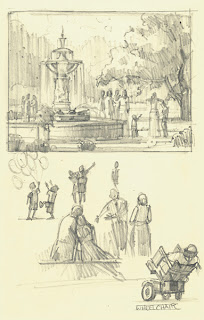
what I see, or rather, how accurately I see, is a matter of practice. Of course drawing from life is best, and I do that whenever I can. This sketchbook page to the left was done sitting on a bench at the Lake Harriet Rose Garden, just minutes from my house. But often a hectic schedule keeps me from going out as much as I would like. In that case, I use anything I have at hand to draw from, magazines, books, catalogs, and photos I've taken. I even draw from some of my favorite websites. Since I'm not selling these sketches and am not profiting from them, I'm not infringing on anyone's copyrights.
There was a time, long ago, when I first started drawing that it wasn't much fun. But that doesn't last too long (only about a year I think). Before long, you will see yourself making progress, and the things that you couldn't do become second nature. I read somewhere that most people give up the new things they are trying to do, just before they would make a breakthrough, and so never succeed. But if you stick with it and are kind to yourself, soon you will look forward to your time with your pencil. I'm going to post some pages from my sketchbooks here to give you an idea as to the different things I draw and the goals I set for myself. Almost always these drawings are loose and don't take a lot of time. Some are looser than others. The goal of a sketchbook is to do quick little studies and train your eye to see size space relationships. The goal is not to create finished drawings to sell or hang on your wall. Oh, and remember, you can click on any image you see for a larger view.
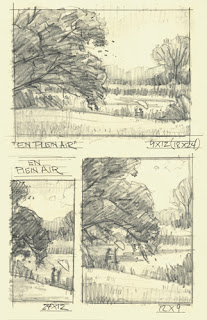
The sketches to the left were done to work out the best composition on a painting idea. I do these all the time. 5-10 minutes on these kinds of sketches will save you a lot of false starts on your easel and wasted time. I also do these when I'm painting on location, and I would recommend if you paint outside too, that you give it a try. You will know immediately if your composition is strong enough to support a painting. Also, I do move things around to make a better painting, so this kind of drawing lets you work it out beforehand. I try different layouts and dimensions too. Sometimes your first idea isn't your best and this will force you to try out new looks and get away from your usual solutions.
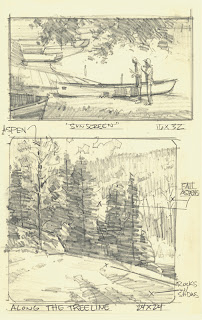
Same with these quick sketches, just a compositional exercise. Sometimes I will fire off a sketch when I get an idea for a painting, just so I don't forget my idea. "Sunscreen" was one of these sketches. Two older folks getting ready to get into their canoe for a day on the water, take a moment to apply sunscreen to each other. Along the Treeline was another compositional sketch to work out getting the focal point clear in my mind.
____________________________________________________________________
This photo had potential for a painting, but was too busy and lacked a place for your eye to rest.
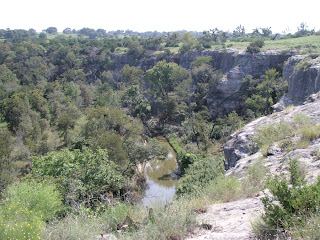
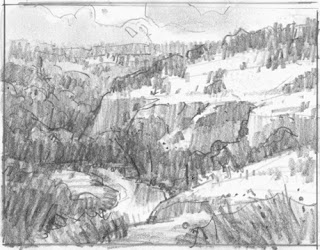
so I did a sketch that added a field at the bottom of the canyon, which solved my problem. It isn't fancy or detailed, but that's not what I needed it for. Here is the finished painting. I used this sketch to refer to as I laid out the underpainting. I only used it as a shorthand drawing.
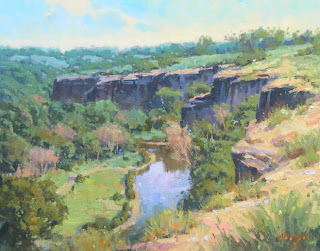
___________________________________________________________________
These drawings, on the other hand, are purely about sketching and training your eye and brain to see size and space relationships. For me this is so very important in my painting. To paint well, you have to be able to see well. If something in your painting seems wrong but you don't quite know what the problem is, you probably have a drawing problem. It doesn't matter how well something is painted, if you aren't accurate in your relationships, you will not be successful. Sorry, but that's just how it is. Being able to draw gives me that ability to see. For me, I make the most progress in training my eye, by doing lots of quick sketches rather than one long labored drawing. I keep a small handheld mirror close by to view my sketch in reverse and make sure I'm on target. Using one of these babies will give you a fresh eye when you've been looking at your drawing for too long and your eye has grown used to your mistakes. Looking at your sketch in the mirror will quickly show you where you've gone wrong so you can correct it. I tend to draw a lot of nudes in these drawings since I find human anatomy to be the most unforgiving subject. If you've gotten it wrong, even just a little, you will usually know it. But don't feel that you have to draw nudes. I draw anything and everything. Whatever I'm interested in, or feel I need to work on is fair game, as you will see.
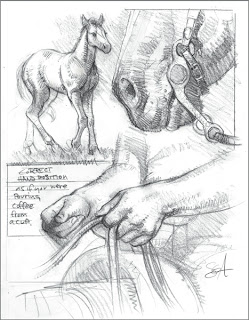
I'm constantly drawing horses and horse anatomy. I like to paint them and must be familiar with their anatomy enough to get it right. In so many ways horse anatomy is every bit as challenging as human anatomy. Even more so for me, because I'm not as familiar with it, so sometimes the mistakes aren't as easy for me to see.
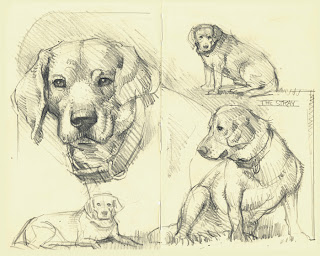
In my sketches of the stray dog that my parents adopted, I was only concerned with getting his gesture and expression. These were quick and not labored.

I love doing the quick character studies of some of the reenactors I meet at the rendezvous I attend. This carpet bagger had a great look. Again, this is quick and I don't labor to get everything exactly right. I'm much more interested in getting something down quickly and getting my eye and brain to intuitively see relationships, angles, and to simplify values.
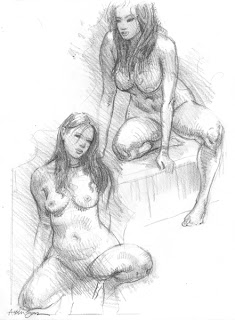
More quick drawings, though longer than a pure gesture drawing. Don't get distracted by unimportant detail. Also, start out drawing light enough so that you can make adjustments as you need to. I'm constantly making corrections as I go. Same with painting. Martin Greele says something to the effect that painting is a series of corrections. The same is definitely true of drawing.

This is about as long a pose as I will do in my sketchbooks, probably about 1-1 1/2 hours.

I also like to put multiple images on each page. And I work at trying to make it pleasing to look at as a whole, I guess it's the Designer/Illustrator in me.
____________________________________________________________________
Well, that's all for now, I hope this gives you some inspiration to pick up your sketchbook and pencil and dive right in. You won't regret it and your paintings will be much easier for you to do.
Happy painting, Steve





















